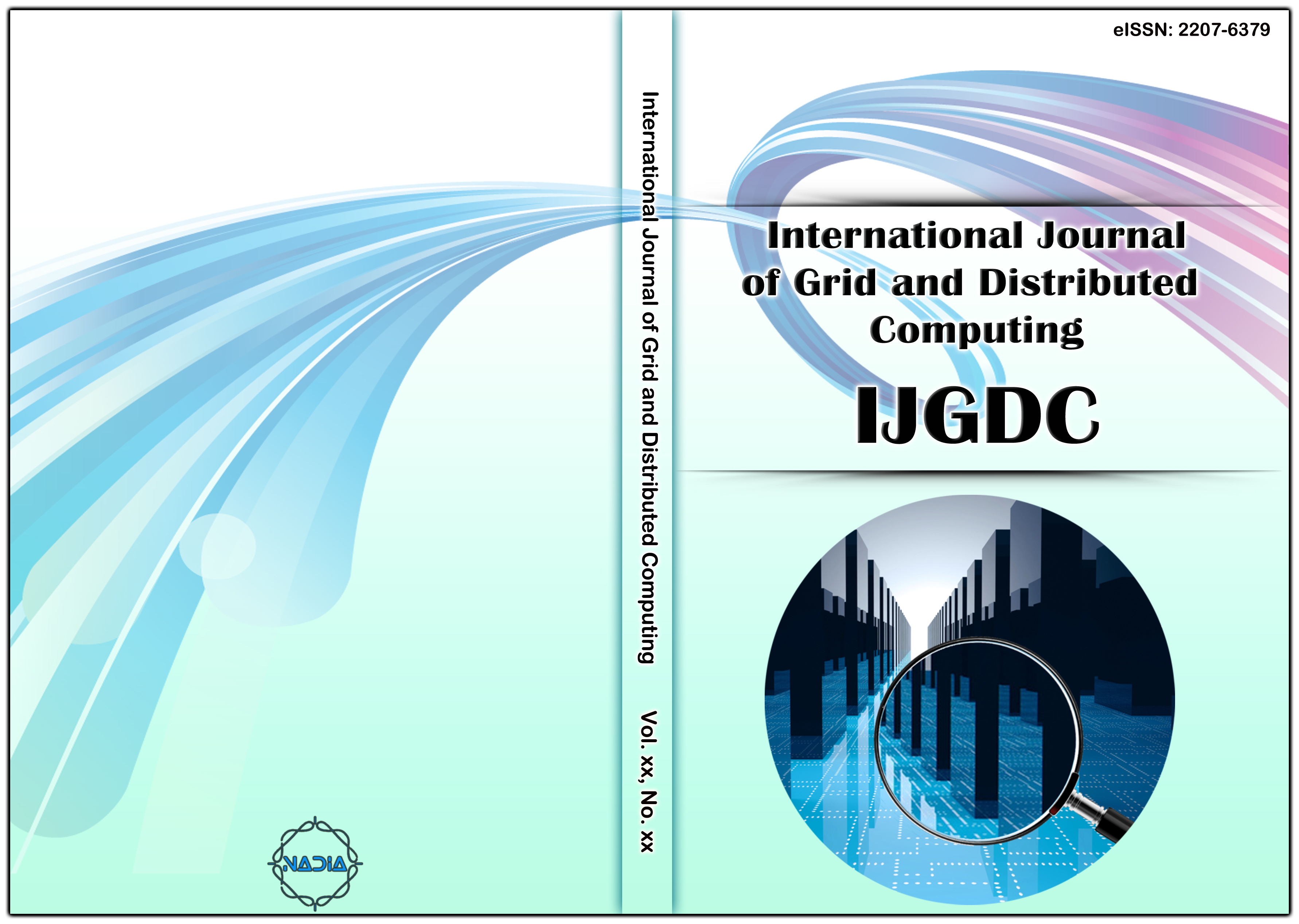[1] Bose R., Roy, S. and Sarddar, D. “User Satisfied Online IaaS Cloud Billing Architecture with the Help of Billboard Manager”, International Journal of Grid and Distributed Computing, vol. 8, no. 2, (2015), pp. 61-78.
[2] Makhlouf, R., “Cloudy transaction costs: a dive into cloud computing economics”, Journal of Cloud Computing, vol. 9, no. 1, (2020), pp. 1-11.
[3] Roy, S. and Sarddar, D. “The Role of Cloud of Things in Smart Cities”. International Journal of Computer Science and Information Security, vol. 14, no. 11, (2016), pp. 683 – 698.
[4] Hentschel, R., Leyh, C. and Petznick, A. “Current cloud challenges in Germany: the perspective of cloud service providers”. Journal of Cloud Computing, vol. 7, no. 5, (2018), pp. 1 – 12.
[5] Bose, R., Roy, S. Mondal, H., Roy Chowdhury, D. and Chakraborty, S. “Energy-efficient approach to lower the carbon emissions of data centers”. Computing, (2021), pp. 1 - 19.
[6] Mukherjee, D., Chakraborty, S., Sarkar, I. Ghosh, A. and Roy, S. “A detailed Study on Data Centre Energy Efficiency and Efficient Cooling Techniques”. International Journal of Advance Trends in Computer Science and Engineering, vol. 9, no. 5, (2020), pp. 9221 – 9242.
[7] Katzer, M. and Crawford, D. “Office 365: Moving to the Cloud. In: Office 365”, Apress, Berkeley, CA, (2014), pp. 1 – 666.
[8] Roy, S., Bose, R. and Sarddar, D. “Self-servicing energy efficient routing strategy for smart forest”. Brazilian Journal of Science Technology, vol. 3, (2016), pp. 1 - 21.
[9] Maluleka, S. M. and Ruxwana, N. “Cloud Computing as an Alternative Solution for South African Public Sector: A Case for Department of Social Development”. New Advances in Information Systems and Technologies, vol. 444, (2016), pp. 481 – 491.
[10] Achilleos, A. P., Kritikos, K., Rossini, A., Kapitsaki, G. M., Domaschka, J., Orzechowski, M., Seybold, D., Griesinger, F., Nikolov, N., Romero, D. and Papadopoulos, G. A. “The cloud application modelling and execution language”. Journal of Cloud Computing, vol. 8, (2019), pp. 1 – 25.
[11] Krishnan, S.P.T. and Gonzalez, J.L.U. “The Google Cloud Platform Difference. In: Building Your Next Big Thing with Google Cloud Platform”. Apress, Berkeley, CA, (2015), pp. 3 – 25.
[12] Jones, S. Irani, Z. Sivarajah, U. Love, P. E. D. “Risks and rewards of cloud computing in the UK public sector: A reflection on three Organisational case studies”. Information Systems Frontiers, vol. 21, (2019), pp. 359–382.
[13] Chakraborty, S., Bose, R., Roy, S. and Sarddar, D. “Auditing Deployed Software Licenses on Cloud Using a Secure Loopback Protocol”. International Journal of Recent Technology and Engineering, vol. 8, no. 3, (2019), pp. 1 – 5.
[14] Bose, R., Chakraborty, S. and Roy, S. “Explaining the Workings Principle of Cloud-based Multi-actor Authentication Architecture on Banking Sectors”. Amity International Conference on Artificial Intelligence, (2019), pp. 764 – 768.
[15] Hongwei, H., Ping, Y. and Nan, Z. “The Design and Implementation of Email Archiving System Based on J2EE”. IFIP Advances in Information and Communication Technology, vol. 452, (2015), pp. 160 – 166.
[16] Tan Beow Aun, M., Goi, B. and Kim, V. T. H. "Cloud enabled spam filtering services: Challenges and opportunities". 2011 IEEE Conference on Sustainable Utilization and Development in Engineering and Technology (STUDENT), (2011), pp. 63 – 68.
[17] Mukhopadhyay, B. Bose, R. and Roy, S. “A Novel Approach to Load Balancing and Cloud Computing Security using SSL in IaaS Environment”. International Journal of Advanced Trends in Computer Science and Engineering, vol. 9, no.2, (2020), pp. 2362 – 2370.
[18] Bose, R. Roy, S. and Sarddar, D. "A Billboard Manager Based Model That Offers Dual Features Supporting Cloud Operating System And Managing Cloud Data Storage". International Journal of Hybrid Information Technology, vol. 8, no. 6, (2015), pp. 229-236.
[19] Bhardwaj, A. and Goundar, S. “Security challenges for cloud-based email infrastructure”. Network Security, vol. 2017, no. 11, (2017), pp. 8 – 15.
[20] Kim, D. and Choi, B.-Y. "HEDS: Hybrid deduplication approach for email servers". 2012 Fourth International Conference on Ubiquitous and Future Networks (ICUFN), (2012), pp. 97-102.
[21] Kaviani, N. Wohlstadter, E. and Lea, R. “Partitioning of web applications for hybrid cloud deployment”, Journal of Internet Services and Applications, vol. 5, (2014), pp. 1 – 17.
[22] Moreno-Vozmediano, R. Montero, R S., Huedo, E. and Llorente, I. M. “Efficient resource provisioning for elastic Cloud services based on machine learning techniques”. Journal of Cloud Computing: Advances, Systems and Applications, vol. 8, no. 5, (2019), pp. 1 – 18.
[23] Momin, M. M. “Role and Relevance of Human Resources Management in Contemporary Profit-Centric Era”. Sinergi, vol. 8, no. 1, (2018), pp. 43 – 47.
[24] “Google Infrastructure Security Design Overview”. Google Cloud Security Whitepapers, (2018), pp. 1 – 97.
[25] “The Total Economic Impact™ of Forcepoint Web Security Cloud and Email Security Cloud Cost Savings and Business Benefits Enabled By Web and Email Security”. FORRESTER, (2017), pp. 1 – 17.
[26] Islam, S., Fenz, S., Weippl, E. and Mouratidis, H. “A Risk Management Framework for Cloud Migration Decision Support”. Journal of Risk and Financial Management, vol. 10, no. 2, pp. 1 – 24.
[27] Verma, R. C. Babu, R. and Lodhi, N. “Class Base Cloud Structure for Effective Cloud Computing”, International Journal of Advancements in Research & Technology, vol. 2, no. 3, (2013), pp. 1 – 5.
[28] Zhao, J. F. and Zhou, J. “Strategies and Methods for Cloud Migration”. International Journal of Automation and Computing, vol. 12, no. 2, (2014), pp. 143 – 152.
[29] Correia, J. Aguiar, A. and Pinto, C. "Cloud computing E-mail systems: Analysis of the current situation in SMEs in Portugal". 2014 9th Iberian Conference on Information Systems and Technologies (CISTI), Barcelona, (2014), pp. 1 - 7.
[30] Sarddar, D., Roy, S. and Bose, R. “An Efficient Edge Servers Selection in Content Delivery Network Using Voronoi Diagram”, International Journal on Recent and Innovation Trends in Computing and Communication, vol. 2, no. 8, (2014), pp. 2326 – 2330.
